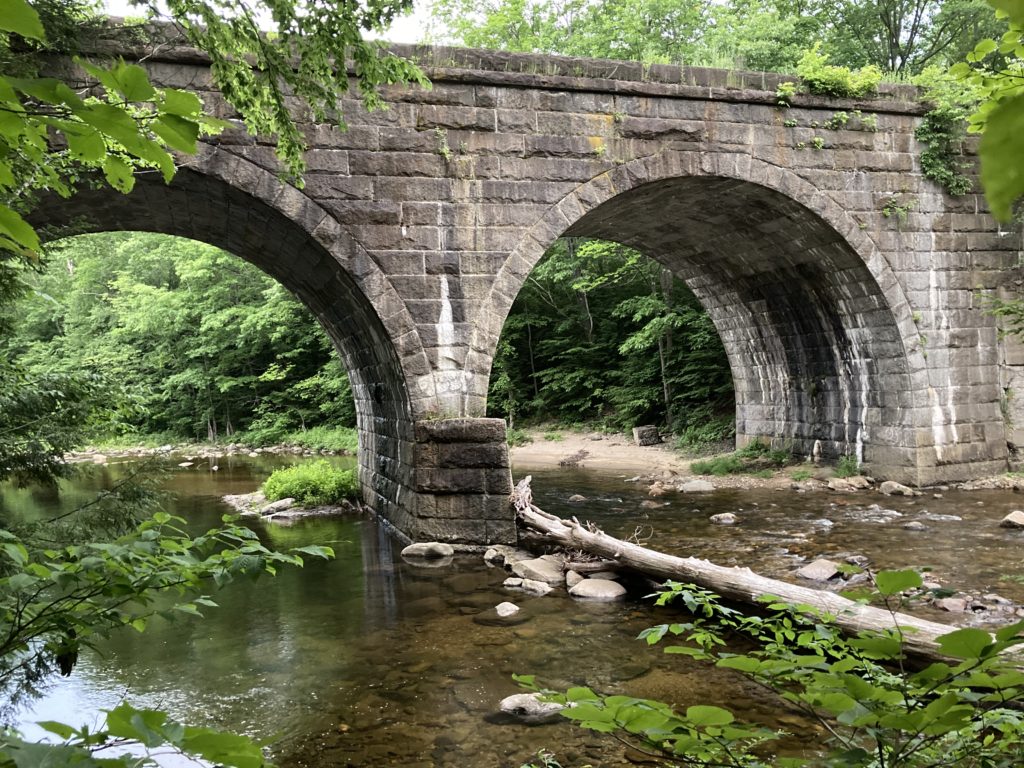Almanac: Grand Relics

Keystone arch bridges trail. Photo: Stephen Braun
Travel practically anywhere in Europe and it won’t be long before you encounter some masonry
remnants of the Roman Empire. Often these are relatively modest walls or arches that have become integrated with, or surrounded by, more modern structures, although the magnificent remains of free-standing aqueducts, arenas, temples, and theaters exist as well, usually as tourist attractions. We don’t have that kind of history here in New England, but you can experience something of the same awe at the building and engineering prowess of past generations of people by taking a walk on the Keystone Arch Bridges trail in Chester (about 40 minutes from Amherst).
A friend and I walked a portion of the 2.5-mile trail last week. The trail itself, which follows the west branch of the Westfield River, is lovely, wide, and only very gently rising or falling. Flora and fauna abound (more on that in a moment) but the real spectacles of any ramble on this path are the massive arched railway bridges built entirely of stone and without mortar in the late 1830s for what was, at its time, a feat of staggering engineering chutzpah.
When a railroad from Boston to Albany was proposed in an attempt to siphon traffic away from New York City, the barrier of the Berkshire mountains was so formidable critics called the idea a “railroad to the moon.” But under the leadership of Major George Washington Whistler and stonemason Alexander Birnie, the railroad was surveyed and built in only two-and-a-half years, using roughly 3,000 men working only with ropes, hand tools, horses, black powder, oxen, and winches. The serpentine course of the river necessitated 27 bridges, culverts, and walls in the mountain section. Most impressive were the 10 single- and double-arch keystone bridges, some as high as 70 feet above the rushing waters. It is astounding enough that most of those bridges have survived the ravages of mountain weather, storms, and major hurricanes since the railway opened in 1841. But some of these bridges, built to carry 30-car trains pulled by engines weighing roughly 12,000 pounds, continue to support 100-car trains pulled by engines weighing up to 400,000 pounds.
Following the trail allows access to four of the remaining bridges, each unique in its design, all massively impressive. You can climb up and walk over two of them, and you can swim in a number of wonderful pools under or near all of them (although this is a pleasant activity only on very hot days).
On our walk last week, we encountered a critter neither of us had seen before: a small, beautifully smooth-scaled grey snake the diameter of a pencil with a bright yellow ring around its neck. It was not particularly frightened of us and let us observe it closely for a minute or two before gliding away into the underbrush.

It was an adult ring-necked snake, the smallest species of snake in the state. These reptiles are harmless and relatively docile, although guides warn that the snake can emit a “foul musk” when handled. Mature ring-necks are only about a foot to 15 inches long — the one we saw was about that size — with a bright yellow or yellow-orange ventral side invisible unless the snake curls up or otherwise shows its belly. We were lucky to see this little guy — or gal — because ring-necked snakes are most active at night while hunting salamanders, earthworms, and slugs.
We had the trail to ourselves that evening, which left us free to appreciate the watery music of the river running in its rocky course, the songs of veerys and wood thrushes, and the silent ghosts of the workers and engineers who built the monuments in stone that still stand as testament to their immense labor and skill.
Almanac is a regular Indy column of observations, musings, and occasional harangues related to the woods, waters, mountains, and skies of the Pioneer Valley. Please feel free to comment on posts and add your own experiences or observations.
